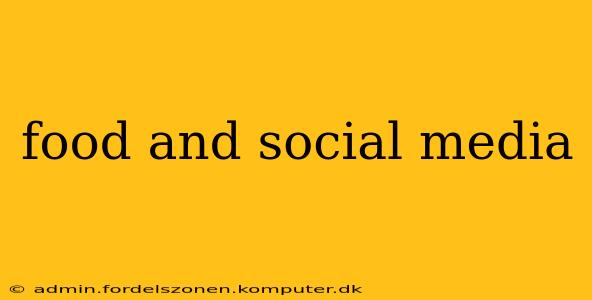The intersection of food and social media is a vibrant and ever-evolving landscape. From the humble food blog to the elaborate influencer-driven campaign, food has become a dominant force on platforms like Instagram, TikTok, and YouTube. This isn't just about pretty pictures; it's a complex interplay of culture, commerce, and community. This article delves into the fascinating relationship between food and social media, exploring its impact on our eating habits, the restaurant industry, and the broader culinary world.
How Has Social Media Changed the Way We Think About Food?
Social media has profoundly altered our perception of food. Gone are the days when culinary inspiration came solely from cookbooks and family recipes. Now, a global tapestry of cuisines is readily accessible, fueling a surge in culinary curiosity and experimentation. The curated aesthetics of food photography and videography have raised the bar for presentation, influencing everything from home cooking to professional restaurant plating. This visual focus, however, can also lead to unrealistic expectations and pressure to achieve picture-perfect meals.
What Are the Most Popular Social Media Platforms for Food?
While various platforms play a role, some stand out as major players in the food-social media ecosystem:
-
Instagram: Its highly visual nature makes it ideal for showcasing aesthetically pleasing dishes. Food bloggers and professional chefs alike utilize Instagram's features like Stories and Reels to engage their audiences with behind-the-scenes glimpses, recipe demonstrations, and mouthwatering photos.
-
TikTok: The short-form video format of TikTok has unleashed a wave of creative food content. From quick recipe hacks and satisfying cooking ASMR to viral food trends and challenges, TikTok has become a significant driver of culinary trends.
-
YouTube: Long-form video content on YouTube allows for more in-depth tutorials, cooking shows, and documentary-style explorations of food culture. Many prominent chefs and food personalities have built large and engaged communities on this platform.
-
Pinterest: While not strictly a social media platform in the same way as others, Pinterest remains a powerful tool for discovering recipes and culinary inspiration. Its visual search functionality makes it incredibly effective for finding specific dishes or techniques.
How Do Restaurants Use Social Media to Attract Customers?
Social media has become an indispensable marketing tool for restaurants. It provides a direct line of communication with potential customers, allowing for targeted advertising, engaging content creation, and real-time customer interaction. Restaurants leverage social media to:
-
Showcase their menu and ambiance: High-quality photos and videos highlight the restaurant's offerings and atmosphere.
-
Run contests and promotions: Engaging contests and special offers drive customer traffic and increase brand awareness.
-
Gather customer feedback: Social media provides a platform for restaurants to monitor reviews, address customer concerns, and gather valuable feedback.
-
Build brand loyalty: Consistent posting and engagement cultivate a strong community around the restaurant's brand.
What Are Some of the Negative Impacts of Social Media on Food and Eating Habits?
While social media offers numerous benefits, it also presents challenges:
-
Unrealistic beauty standards: The emphasis on aesthetically perfect food can lead to unrealistic expectations and body image issues.
-
Increased pressure to eat specific foods: The constant exposure to trendy foods can create pressure to consume certain items, potentially neglecting personal dietary needs and preferences.
-
Promotion of unhealthy eating habits: While there's plenty of healthy food content, social media can also promote processed foods and unhealthy eating habits.
-
Spread of misinformation: The rapid dissemination of information on social media can lead to the spread of misinformation about food and nutrition.
How Can I Use Social Media to Improve My Own Cooking and Eating Habits?
Social media can be a powerful tool for improving your cooking and eating habits:
-
Find inspiration and recipes: Explore diverse cuisines and cooking styles to expand your culinary horizons.
-
Connect with other food lovers: Engage with communities of like-minded individuals for support, tips, and motivation.
-
Track your progress: Use social media to document your culinary journey, setting goals and celebrating achievements.
-
Learn new skills: Follow chefs and food bloggers to learn new techniques and recipes.
Is it True That Social Media Influences Our Food Choices?
Yes, overwhelmingly, social media significantly influences our food choices. The constant stream of visually appealing food content, endorsements from influencers, and trending recipes create a powerful effect on our purchasing decisions and dietary habits. This influence is amplified by targeted advertising and the social nature of platforms, encouraging conformity and the desire to participate in shared culinary experiences.
What Are the Ethical Considerations of Food Marketing on Social Media?
Ethical considerations are crucial when discussing food marketing on social media. Transparency is paramount – influencers should clearly disclose sponsored content, and brands should be upfront about their marketing strategies. Furthermore, promoting unhealthy food options to vulnerable audiences needs careful consideration and should adhere to responsible advertising guidelines. The ethical use of social media in food marketing requires a commitment to honesty, accuracy, and the well-being of consumers.
In conclusion, the relationship between food and social media is complex and multifaceted. While it offers incredible opportunities for culinary exploration, education, and community building, it's crucial to be aware of the potential pitfalls and to approach this digital landscape with a critical and discerning eye.
